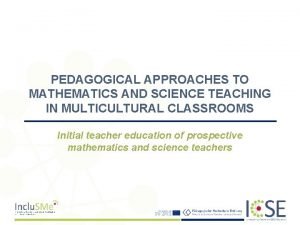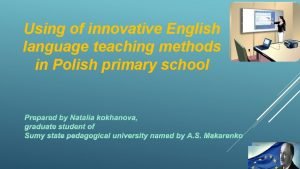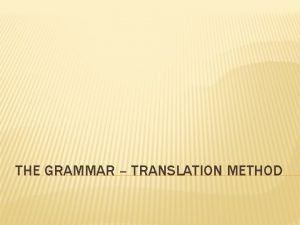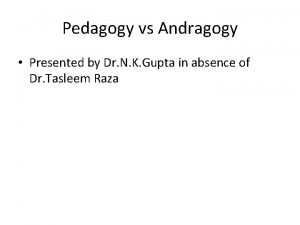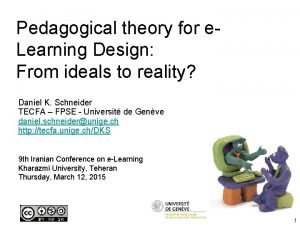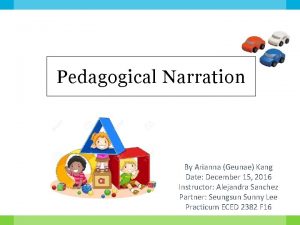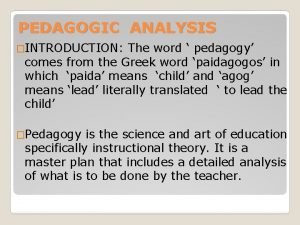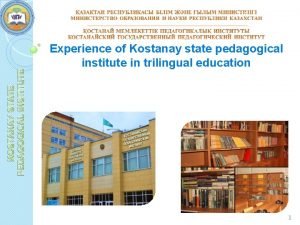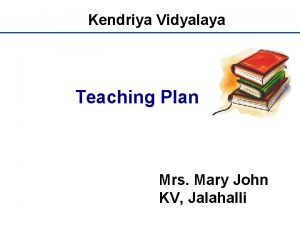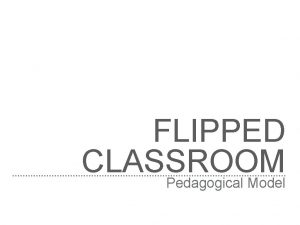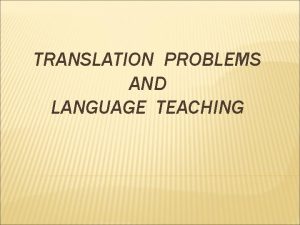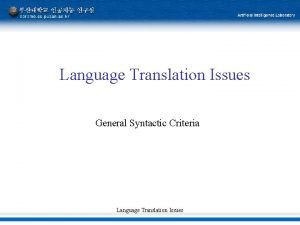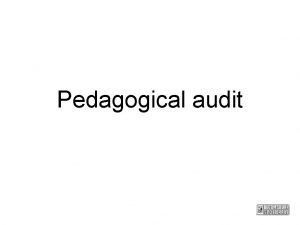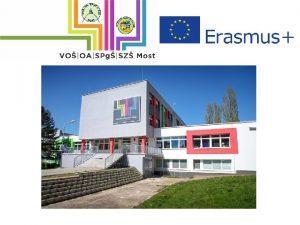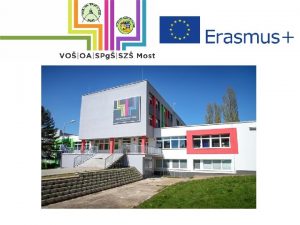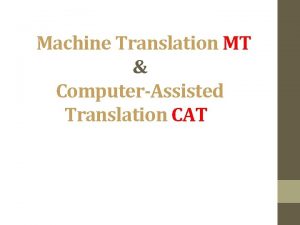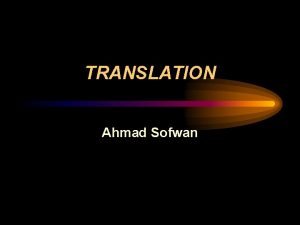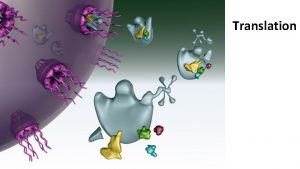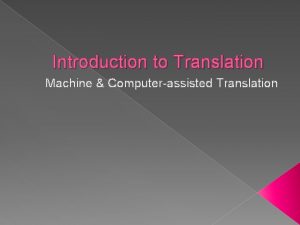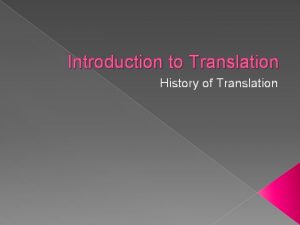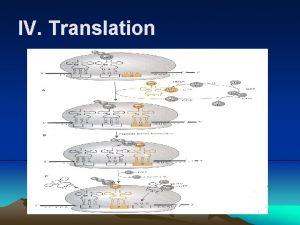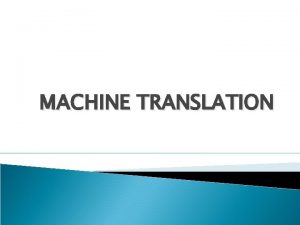Pedagogical Translation in English Language Teaching its Model

















- Slides: 17

Pedagogical Translation in English Language Teaching: its Model and Research Design (Dissertation: Using Pedagogical Translation in English Language Teaching) Michaela Šamalová 12 th ESSE Conference, UPJŠ Košice 29 August - 2 September 2014

Overview Theoretical framework Aims Research design Sampling Measure Data analysis Pedagogical Translation Model

Key Terms Pedagogical translation (PT) Pretest-posstest control group quasi-experiment Quantitative research Communicative Approach

Challenge 'Translation has been too long in exile, for all kinds of reasons which… have little to do with any considered pedagogic principle. It is time it was given a fair and informed appraisal. ' Widdowson 2003: 160

Aims • Determine the influence of pedagogical translation on learners‘ language skills • Establish new understandings of the application of pedagogical translation in English language teaching

Research Design: Pretest-Posttest Control Group Quasi Experiment Pre-research study 2014 Sampling Students Teachers Interviews Seminars 2015 Pretest Application of PT Posttest Test evaluation, data analysis 2016 Replication study Test evaluation, data analysis Teachers‘ feedback

Sampling & Procedure 150 – 180 learners 5 – 6 schools Pre-research Study Sampling Students Teachers Interviews Controlled extraneous variables • • Type of school and year of study Level in English (CEFR A 2 -B 1) Textbook Teachers Seminars Pretest Application of PT Posttest Experimental vs. control group Non-random assignment Replication study Test evaluation, data analysis Teachers‘ feedback

Application of PT Pre-research Study Sampling Students Experimental group × Control group Feedback • Reflective diaries In-class observations Teachers Interviews Seminars Pretest Application of PT Posttest Test evaluation, data analysis Replication study Test evaluation, data analysis Teachers‘ feedback

Measure & Data Analysis Pretest Posttest Pre-research Study Sampling Students Teachers Interviews Seminars Pretest Standardized language tests Application of PT Teachers‘ feedback Posttest Test evaluation, data analysis Replication study Test evaluation, data analysis Teachers‘ feedback

Translation and the Communicative Approach?

Pedagogical Translation: Past PEDAGOGICAL TRANSLATION CONTENT PROCEDURES AIMS READING SKILLS WRITING SKILLS

Contemporary Pedagogical Translation: Theoretical Foundations Belief that learner‘s mother tongue influences the process of second language acquisition (SLA) Contemporary theories of SLA Cross-Linguistic Influence (Terence Odlin) Cross-Linguistic Similarity (Hakan Ringbom) Communicative Approach Contemporary goals of foreign language instruction Framework Educational Programme External influences

Pedagogical Translation LANGUAGE PROXIMITY LANGUAGE DISTANCE PEDAGOGICAL TRANSLATION COMMUNIC. COMPETENCE LEARNER DIFFERENCES CONTENT AIMS READING SKILLS WRITING SKILLS PROCEDURES SPEAKING SKILLS LISTENING SKILLS CONTEXTUAL FACTORS

External influences Language proximity × language distance Learner differences Relative learner‘s proficiency in L 2 Preferred learning strategies Previous experience with learning a L 2 Motivation, personal traits, etc. Cognitive processes Interlingual identification Learner‘s subjectivity Contextual factors

Summary ‘Modern translation activities have clear communicative aims and real cognitive depth, show high motivation levels and can produce impressive communicative results. ‘ Kaye, 2009

References • • • • Cook, G. (2012). Translation in Language teaching. Oxford: Oxford University Press. Duff, A. (1898). Translation. Oxford: Oxford University Press. Gall, M. , Gall, J. , & Borg, W. ( 1996). Educational Research: An Introduction. New York: Longman, . Gall, M. , Gall, J. , & Borg, W. (c 2010). Applying educational research: how to read, do, and use research to solve problems of practice. Boston: Pearson. Gavora, P. (2010). Úvod do pedagogického výzkumu. Brno: Paido. Hendrich, J. et al. (1988). Didaktika cizích jazyků. Praha: Státní pedagogické nakladatelství. Kaye, P. (2009). Translation activities in the language classroom. Retrieved from https: //www. teachingenglish. org. uk/article/translation-activities-language-classroom Leonardi, V. (c 2010). The role of pedagogical translation in second language acquisition: from theory to practice. Bern: Peter Lang. Malmkjaer, K. et al. (1998). Translation and Language Teaching and Translation. Manchester: St. Jerome Publishing. Odlin, T. Cross-Linguistic Influence. In: Doughty, C. , & Long, M. (c 2003). The handbook of second language acquisition. (ix, 888 s. ) Malden: Blackwell Publishing. Odlin, T. (1989). Language Transfer: Cross-linguistic Influence in Language Learning. Cambridge: Cambridge University Press. Ortega, L. (2009). Understanding Second Language Acquisition. London: Hodder Education. Ringbom, H. (c 2007). Cross-linguistic similarity in foreign language learning. (viii, 144 s. ) Clevedon: Multilingual Matters. Stoddart, J. (2000). Teaching Through Translation. The Journal 11 (pp. 6 -13). Švaříček, R. , & Šeďová, K. (2007). Kvalitativní výzkum v pedagogických vědách. Praha: Portál. Widdowson, H. G. (2003). Defining Issues in English Language Teaching. Oxford: Oxford University Press.

Thank you Michaela Šamalová Masaryk University, Faculty of Education Brno, Czech Republic E-mail: 183825@mail. muni. cz
 Pedagogical translation
Pedagogical translation Pedagogical approaches to teaching math
Pedagogical approaches to teaching math Techniques of direct method
Techniques of direct method Macam evaluasi
Macam evaluasi Innovative methods of teaching english language
Innovative methods of teaching english language English language teaching institute
English language teaching institute Approach, method, technique
Approach, method, technique Communicative translation meaning
Communicative translation meaning Voice translation-rule
Voice translation-rule Function transformations
Function transformations Noun phrase example
Noun phrase example Advantages and disadvantages of gtm
Advantages and disadvantages of gtm Pedagogical vs andragogical
Pedagogical vs andragogical Pedagogical design for e learning
Pedagogical design for e learning Examples of pedagogical narration
Examples of pedagogical narration Steps in pedagogical analysis
Steps in pedagogical analysis Kostanay state pedagogical institute
Kostanay state pedagogical institute Lesson plan kvs bangalore region
Lesson plan kvs bangalore region

